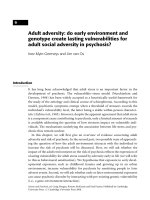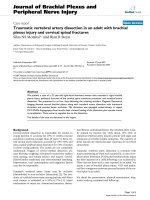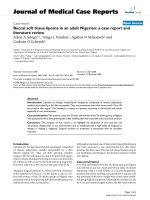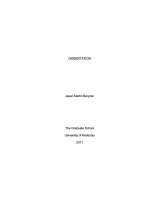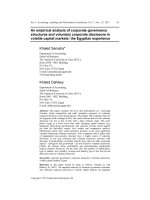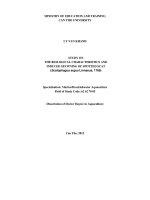An adult accelerated degree program, student and instructor perspectives and factors that affect retention
Bạn đang xem bản rút gọn của tài liệu. Xem và tải ngay bản đầy đủ của tài liệu tại đây (2.13 MB, 182 trang )
An Adult Accelerated Degree Program:
Student and Instructor Perspectives and Factors that Affect Retention
Cindy K. Manjounes
May 2010
A dissertation submitted to the Education Faculty of Lindenwood University in partial
fulfillment of the requirements for the degree of
Doctor of Education
School of Education
UMI Number: 3426996
All rights reserved
INFORMATION TO ALL USERS
The quality of this reproduction is dependent upon the quality of the copy submitted.
In the unlikely event that the author did not send a complete manuscript
and there are missing pages, these will be noted. Also, if material had to be removed,
a note will indicate the deletion.
UMI 3426996
Copyright 2010 by ProQuest LLC.
All rights reserved. This edition of the work is protected against
unauthorized copying under Title 17, United States Code.
ProQuest LLC
789 East Eisenhower Parkway
P.O. Box 1346
Ann Arbor, MI 48106-1346
Acknowledgments
Thanks to the following people for encouragement, support, readership, and
valuable insight throughout the entire dissertation process: Dr. Jann Weitzel, Dr. Rita
Kottmeyer, Dr. Chad Holloway, Ms. Diana Stanfill, Ms. Ann Hoffman, Dr. Susan
Isenberg, Dr. Sherrie Wisdom, Dr. John Henschke, Dr. Charlene Engleking, Dr. Deb
Ayers, and Dr. Cynthia Bice. A special thank-you to Dr. Larry Matthews for his patience
and help with my relearning of statistics; his insight and humor are sorely missed.
Thank you also to my wonderful coworkers and to my dean for their consistent
encouragement and willingness to always assist in whatever way I asked. Dan Kemper,
Billi Patzius, Charlene Engleking, Terry St. Clair, Jim Horstmeier, Angela Holden, Beth
Mead, Michael Castro, Rita Kottmeyer, Lori Malloy, Andrea Frazier, and Mark Lerman,
I could not have done this without you.
A special thank-you goes to my husband John whose constant patience and
support made this all possible. Thanks also to my parents, sister, and brothers for your
loving encouragement and support—you-all gave me the foundation I needed to be
successful.
i
Abstract
This was a blended qualitative and quantitative study, which investigated adult student
and instructor perspectives, motivators, factors and life events that have affected adult
students as they pursue their degrees. This study also examined the environment, format,
and course content of accelerated degree programs. This study focused solely on
undergraduate degree programs. The null hypothesis of this study was that accelerated
degree programs for adult students will not result in higher retention rates than traditional
day programs. The null hypothesis was rejected. This study is significant because, as
pointed out in Stephanie Armour’s June 12, 2003, USA Today article, adults are returning
to colleges and universities in unprecedented numbers. Adult learning habits,
motivations, and life circumstances differ substantially from those of the traditional
student, and the differences must be understood if the higher education community is to
properly serve their adult students. This study examined the adult student from a variety
of aspects, and for the purposes of this study, only undergraduate students were surveyed.
Data were gathered from student surveys and a focus group discussion. Surveys showed
relationships and development of trust were important to instructors and students and that
a variety of external factors, including financing the degree, academics, advising and
classroom location, all were important to the adult student. Retention data from both
traditional and accelerated programs at the study university were analyzed to determine if
any significant differences in retention existed between these varied programs. The study
did find a significant difference between the programs. An accelerated program of
undergraduate degrees was examined in-depth. Results from the examination indicated
that the accelerated program was highly regarded by adult student participants, the adult
ii
students felt respected, the students felt the academic requirements of the program were
challenging, but not impossible to achieve, and that the education they were working to
achieve was of utmost importance to future career prospects and to their personal selfefficacy. Institutions of higher learning considering implementation or revision of
existing accelerated programs targeting adult students will benefit from this study by the
insights provided and from the review of a successful accelerated program.
iii
Table of Contents
List of Tables ..................................................................................................................... ix
List of Figures ..................................................................................................................... x
Chapter One – Introduction ................................................................................................ 1
Background of the Problem .................................................................................... 1
Purpose of the Study ............................................................................................... 4
Importance of the Study .......................................................................................... 5
Definition of Terms................................................................................................. 6
Limitations of the Study.......................................................................................... 9
Delimitations of the Study .................................................................................... 10
Assumptions.......................................................................................................... 10
Summary ............................................................................................................... 12
Chapter Two – Literature Review..................................................................................... 13
Evolution of Adult Education ............................................................................... 14
Economic changes .................................................................................... 14
Challenges to the process .......................................................................... 15
Non-traditional students – drivers of success ........................................... 17
Students’ needs and societal expectations ................................................ 19
Adult Learning ...................................................................................................... 20
Styles and motivators ................................................................................ 21
Far-reaching affects .................................................................................. 23
Models and orientation ............................................................................. 25
Accelerated Education .......................................................................................... 27
iv
Adult access to education and development of accelerated
programs ....................................................................................... 28
Creation of programs ................................................................................ 29
Success determinants ................................................................................ 31
Academic dissent ...................................................................................... 32
Flexibility for adult students ..................................................................... 34
Adult student perspectives ........................................................................ 36
External Factors Influencing Adult Higher Education ......................................... 38
Finances as a factor in adult education ..................................................... 38
Disparities in adult education – the United States economy..................... 39
Adult Student Degree Completion ........................................................................ 42
Persistency ................................................................................................ 42
Retention versus departure ........................................................................ 43
Student departure/non degree completion ................................................ 46
Prior college credits .................................................................................. 48
Importance of Advising ............................................................................ 50
Summary ............................................................................................................... 52
Chapter Three – Methods.................................................................................................. 53
Research Questions and Hypothesis ..................................................................... 53
Programs Examined for Study .............................................................................. 54
Instrumentation ..................................................................................................... 56
Methodology ......................................................................................................... 57
Gathering data from students .................................................................... 57
v
Focus Groups ............................................................................................ 58
Gathering of retention data ....................................................................... 60
Data Analysis ........................................................................................................ 61
Use of Perspectives Inventories with Students and Instructors ............................ 61
Chapter Four – Results...................................................................................................... 63
Results and Analysis of Data from Paper Surveys of LCIE Students .................. 64
Information by Survey Location ........................................................................... 65
Survey Responses to Education Plans and Preferences ........................................ 66
Responses to questions 1 to 6 – motivations ............................................ 66
Responses to questions 7 to 11 – finances ................................................ 70
Response to question 12 – scheduling ...................................................... 72
Responses to questions 13 to 16 – academics ........................................... 72
Responses to questions 17 to 21 – advising .............................................. 73
Focus Group Discussion ....................................................................................... 74
Analysis of Data .................................................................................................... 75
Participant responses – focus group discussion ........................................ 75
Modified Instructional Perspectives Inventory Surveys ........................... 78
Modified Instructional Perspectives Inventory – Adapted for
Students (MIPI-S) ......................................................................... 81
Retention Data ...................................................................................................... 84
Summary ............................................................................................................... 89
Chapter Five – Discussion and Recommendations ........................................................... 91
Discussion ............................................................................................................. 91
vi
Answers to Research Questions and Hypotheses ................................................. 91
Results of Paper Surveys of LCIE Students ......................................................... 94
Responses to survey questions 1 to 6 – motivations ................................. 95
Responses to survey questions 7 to 11 – finances .................................... 96
Responses to question 12 – scheduling ..................................................... 98
Responses to questions 13 to 16 – academics ........................................... 99
Responses to questions 17 to 21 – advising ............................................ 100
Summary Results of Focus Group Discussions .................................................. 101
Modified Instructional Perspectives Inventory Analysis (MIPI) ........................ 102
Modified Instructional Perspectives Inventory – Adapted for Students
(MIPI-S) Analysis ................................................................................... 105
Retention Information Analysis .......................................................................... 108
Findings of the Study .......................................................................................... 110
Further Discussion .............................................................................................. 111
Summary and Conclusions ................................................................................. 112
References ....................................................................................................................... 114
Appendix A – Adult Education Survey .......................................................................... 127
Appendix B – Cover Letter for AES............................................................................... 130
Appendix C – Consent form for AES ............................................................................. 131
Appendix D – Breakdown by Question of AES Responses ........................................... 132
Appendix E – Consent form for Focus Group ................................................................ 153
Appendix F – Focus Group Questions ............................................................................ 155
Appendix G – Modified Instructional Perspectives Inventory ....................................... 156
vii
Appendix H – Graphic Analysis Modified Instructional Perspectives Inventory .......... 160
Appendix I – Modified Instructional Perspectives Inventory –
Adapted for Students (MIPI-S) ....................................................................................... 161
Appendix K – General Education Requirements for LCIE Program ............................. 166
Vitae ............................................................................................................................. 167
viii
List of Tables
Table 1 – Adult and Child Learning Characteristics ........................................................ 21
Table 2 – Andragogy and Pedagogy – Differences Explained ..........................................23
Table 3 – Contrast of Campus Responses to Survey ........................................................ 65
ix
List of Figures
Figure 1 – Question 1 – Pursuit of degree and income potential ...................................... 67
Figure 2 – Question 2 – Pursuing degree for new occupation ...........................................68
Figure 3 – Question 3 – Pursuing degree personal satisfaction/happiness ....................... 69
Figure 4 – Question 8 – Grants and scholarships/factors in funding ................................ 71
Figure 5 – Question 10 – Tuition reimbursement factor....................................................71
Figure 6 – Question 12 – Scheduling classes and location ............................................... 72
Figure 7 – Modified Instructional Perspectives Inventory Totals .................................... 80
Figure 8 – Modified Instructional Perspectives Inventory Mean ......................................80
Figure 9 – Total average points – student by factor.......................................................... 82
Figure 10 – Mean for student by factor ............................................................................ 83
Figure 11 – Retention traditional program.........................................................................86
Figure 12 – First time/ full time student retention ............................................................ 88
Figure 13 – Returning full time students .......................................................................... 88
Figure 14 – NCES percentage distribution non-traditional and traditional .................... 109
x
Adult Students and Accelerated Education
1
Chapter One – Introduction
Background of the Problem
Adults are returning to college in unprecedented numbers. Adult students are
defined in this paper as students over 22 years of age, and they currently comprise
approximately 44% of the postsecondary students in the United States (Chao, DeRocco,
& Flynn, 2007). The higher education system cannot afford to ignore this market
segment, as it constitutes nearly one half of their potential market. According to Siebert
and Karr (2003), the colleges most effective at attracting, retaining, and graduating adult
students are those colleges that are highly resilient and demonstrate excellent emotional
intelligence with adult students. The resilience of these institutions fosters adaptability to
change, and their emotional intelligence demonstrates the acute awareness and ability to
assess and manage the emotional needs of their students in a productive manner. The
traditional attitude of academic nobility with an elitist separation between teacher and
student is slowly dissipating. It is this resilient institutional focus and the need to get
outside of the traditional mentality that has forced many of the colleges and universities
to begin considering accelerated programs for their adult students. Accelerated programs
allow for faster completion of degree requirements than traditional programs, hence
providing more quickly the solution adult students are looking for to advance their career
potential.
The lagging economy, along with an abundance of other motivators, is
compelling adults to challenge traditional academic programs and their structure.
Traditional academic thinking and planning has historically been focused on the
18-year-old student who comes directly to college from high school with little or no
Adult Students and Accelerated Education
2
college credit. Programs for these students have been structured for classes to take place
from 8:00 a.m. to approximately 4:00 p.m., Monday through Friday. Colleges and
universities have sporadically offered classes in the evening hours without much thought
given to what was actually needed by whom. Then entered the adult student, and a whole
new academic mindset focused on the needs of the adult learner began to evolve.
Traditional academic services and programs did not meet the adult student’s unique
needs. The traditional system has been challenged, and that challenge is the basis upon
which this dissertation was conceived.
Just as stress increases as life-changing events accumulate, the motivation to cope
with change through engagement in a learning experience increases (R. Zemke & Zemke,
1984). The decision to enter higher education as an adult learner is often predicated and
motivated by life transitions (Merriam & Caffarella, 1999). Transitions with which adult
students are typically coping often include major life events, such as changes in job
status, marital status, or becoming parents. The adult student wants to make sure that
whatever avenue of education he or she chooses is adaptable to his or her lifestyle or that
necessary accommodations can be made to his or her lifestyle while working to complete
the desired degree.
Adults over the past 20 years have been entering the higher education system with
varying levels of work experience and previous education (Diefenderfer, 2009). Some
students have decided to go to work directly out of high school, be it for necessity or
other reasons. Students may have had to seek employment directly after high school
because school had been a struggle for them, and they did not want to continue that
struggle. Some students have chosen to start their families at a young age, while others
Adult Students and Accelerated Education
3
have decided to go directly into the military. Whatever the decision may have been, they
were either delaying college entry or not giving consideration to going to college at all.
As the economy, and industry along with it, began to fluctuate, many employers began
demanding workers with more developed skill sets. Adults still needed to work; however,
they were seeking venues to develop the skills needed to further their careers and, ideally,
increase their income.
Adults have been motivated by many factors to either begin or finish a degree
program, and the challenges they faced may have seemed insurmountable at times.
Motivations for adults returning to school include improvement in finances, job
promotion, career change, and lifestyle changes. Lindeman (1925) stated,
Adult education is a co-operative venture in non-authoritarian, informal learning
the chief purpose of which is to discover the meaning of experience; a quest of the
mind which digs down to the roots of the preconceptions which formulate our
conduct; a technique of learning for adults which makes education coterminous
with life, and hence elevates living itself to the level of an experiment. (pp. 7–8)
The cooperative venture of adult education is challenged by the traditional
academic view of what a college education and a college student should look like. These
challenges are forcing traditional programs to rethink their options and become creative
with alternatives that are tailored to fit the unique needs of the adult student. The
creativity and uniqueness of these nontraditional and often accelerated education program
structures are causing them to undergo scrutiny by traditional academics who question
the integrity of such programs. The traditional system of academia cannot ignore adult
Adult Students and Accelerated Education
4
students, nor can it expect them to conform to traditional academic schedules and
program structure.
Purpose of the Study
The first purpose of the study was to examine adult student and instructor
perspectives and to investigate motivators, factors, and life events that have affected adult
learners as they pursue their degrees. The second purpose of this study was to examine
the environment, format, and course content of accelerated degree programs to determine
if these programs are more conducive to adult students’ wants and needs than traditional
programs, thus enhancing student retention. Theoretical explanations coupled with
real-life application were used to explain and correlate evidence to substantiate claims
made by the principal researcher regarding the adult student population. Very few
in-depth studies have been performed regarding adult higher education and even fewer
regarding accelerated programs. The study’s results provide an in-depth view of the
Lindenwood College for Individual Education (LCIE) program at Lindenwood
University in St. Charles, Missouri, that could be used as a basis for other institutions in
building and examining their own accelerated adult-focused programs.
The principal researcher examined not only adult learning styles and academic
rigor, but also investigated another integral part of any higher education program:
advising. Via written surveys distributed to students of the LCIE program at Lindenwood
University and via focus groups conducted with these same students, questions were
asked regarding the advising that students have experienced while enrolled in the
program. Through these surveys and focus groups, valuable information was attained that
Adult Students and Accelerated Education
5
may help structure faculty advisement to operate in the most efficient way in order to
benefit both the educational institutions and their students.
The results of this study will serve the higher education community in that it
examined in depth why adult students return to school and what keeps them there until
completion of the degree. The study examined both extrinsic and intrinsic motivations for
students to complete their degrees. Adult students who have chosen the traditional
program of study were compared and contrasted with adults who have chosen the
accelerated format for study. The purpose for this contrast was to determine what factors
propelled the students toward one program or another and what effect time toward
completion had in their program decision.
Importance of the Study
The composition of the student body at colleges and universities today is not the
same as it was 20 years ago, and the evolution of higher education continues. The
importance of this study is evidenced by the aforementioned numbers of adult students—
44% of all undergraduates—who are returning to higher education to begin or complete a
previously started degree program (Chao et al., 2007). This statistic shows that adult
students comprise a market segment that is worthy of the attention of institutions of
higher learning. Challenging economic times are forcing institutions of higher education
to either establish accelerated and evening programs of study or revise the programs they
are currently offering.
The United States has long been recognized as one of the world’s most
prosperous and successful nations. Roughly 39% of Americans hold a 2-year or 4-year
degree (Organization for Economic Cooperation and Development [OECD] 2008). This
Adult Students and Accelerated Education
6
statistic is being overshadowed by the fact that degree attainment rates in other nations
continue to climb, while the degree attainment rates of the United States remain stagnant.
In other leading countries, nearly half of all young adults (25–34-year-olds) have college
degrees (OECD, 2008). The United States simply cannot afford to fall behind and
compromise its economy and its citizens. If the United States is to keep pace with the rest
of the world and be able to educate the adult student population, universities and colleges
must provide the solutions. This will require challenging the traditional academic
thinking and images that have permeated the American society for a number of years.
The technological advances and economic demands of the current economy
necessitate a well-prepared and educated workforce. Evolutions in industry that force
many people to make career path alterations later in life corroborate the need for degree
programs to fit the adult learner. This study examined the thought process of adult
learners and factors that are important to them. By looking more deeply into the
motivations for the adult learner and attempting to understand how they best absorb the
necessary information, colleges and universities can provide the most viable and
well-managed means of education to help adult students reach their goals. It is of utmost
importance that while the institutions of higher education are striving to meet these goals,
they retain the academic integrity necessary to provide a worthy education. Consistent
review and scrutiny of accelerated programs is needed to ensure this is accomplished.
Definition of Terms
Academic integration – the degree to which students feel they fit into the
academic life of an institution (Brown, 2002).
Adult Students and Accelerated Education
7
Accelerated degree programs – degree programs composed of courses that are
provided in a non-traditional format, usually in the evening. Students can earn their
degrees often by only attending class one night a week or on weekends. Programs are
typically tailored for working adults as their primary audience, blending experience with
education and teaching in an interactive format.
Adjunct professor – the title of a person who teaches on the college level but is
not a full-time professor. He or she may teach only one or more courses during a
semester, and future courses are typically not assured. Adjunct professors usually do not
receive benefits such as health, life, or disability insurance, nor do they receive employer
contributions for retirement.
Adult students – for the purposes of this study, are those students entering a
college or university at the age of 22 years or older at the time of admission.
Andragogy – the art and science of helping adults learn (Clardy, 2005).
Cognitive learning – the process of enabling people to learn by using their reason,
intuition, and perception. This technique is often used to change a person’s behavior. A
person’s behavior is influenced by many factors, such as culture, upbringing, education,
and motivation. Cognitive learning involves understanding how these factors influence
behavior and then using this information to develop learning programs (Martin, 2009).
Experiential learning – the knowledge and skills acquired through life, work
experience, and study which have not been formally certified through any educational or
professional certification.
Integrated Postsecondary Education Data System (IPEDS) – a system of
interrelated surveys conducted annually by the National Center for Education Statistics
Adult Students and Accelerated Education
8
(NCES). IPEDS gathers information from every college, university, and technical and
vocational institution that participates in federal student financial aid programs. Required
reporting is supported by the Higher Education Act of 1965, which requires all
institutions that participate in federal student aid programs to report data on enrollments,
program completions, graduation rates, faculty and staff, finances, institutional prices,
and student financial aid (U.S. Department of Education, n.d.).
Institutions of higher learning – those universities, community colleges,
vocational technical schools, and liberal arts colleges that provide degrees or certificates
for individuals who have completed high school education requirements prior to entering
the higher education programs offered by these institutions.
The Lindenwood College for Individualized Education (LCIE) – is the accelerated
course format that provides both graduate and undergraduate degrees at Lindenwood
University.
Lifelong learning accounts – employer-matched, portable, employee-owned
accounts used to finance education and training. These accounts encourage the creation
of a partnership between workers and employers to effectively leverage resources to
increase productivity, improve recruitment and retention, and meet the changing needs of
our economy. These accounts are intended to supplement, not replace, existing employersupported tuition assistance programs (Council for Adult and Experiential Learning
[CAEL], 2005).
Lumina Foundation for Education (Lumina Foundation) – an Indianapolis-based,
private, independent foundation, that strives to help people achieve their potential by
expanding access to and success in education beyond high school. Through grants for
Adult Students and Accelerated Education
9
research, innovation, communication, and evaluation, as well as policy education and
leadership development, Lumina Foundation (2009a) addresses issues that affect access
and educational attainment among all students, particularly underserved student groups,
including adult learners.
Persistence – If a student is continuously enrolled for more than two successive
terms, then they are said to be persistent.
Retention – a method of measurement which tracks a student through a degree
program over time to determine if the student has completed the program.
Student Departure – when a student leaves a degree program and does not ever
return to complete the degree. According to Tinto’s theory of departure, students depart
because they do not separate themselves from their families and past and socially
integrate themselves to the college or other institution (as cited in Braxton, Milem, &
Sullivan, 2000).
Traditional students – for the purposes of this study, are those who go to college
either directly from high school or shortly thereafter and are typically 17–19 years old.
Transferrable skills – are those reasonably developed skills, knowledge, and
abilities attained through both training and experience (civilian and military) that relate to
current employment opportunities in the labor market (Fugleberg, 2004).
Limitations of the Study
Accelerated learning and degree programs were investigated to determine if they
are more conducive to adult learning styles, thus contributing to student retention and
greater actual degree attainment. Only undergraduate degrees were examined. Adult
students who were contacted were enrolled in either traditional or accelerated programs at
Adult Students and Accelerated Education
10
Lindenwood University. The principal researcher discovered a limitation as this study
developed.
The evident limitation for this study was the comparison of traditional and
non-traditional adult students. At Lindenwood University in spring 2009, there were only
12 students who fit the definition of adult student as established by this paper enrolled in
traditional day programs. There were approximately 728 valid written responses received
to the survey distributed to the adult undergraduate students in the accelerated programs.
Delimitations of the Study
This study is not about the average 18–22-year-old traditional college student who
goes directly into college from high school. A definition of adult student is contained
within the “Definition of Terms” section of this chapter. Only research related to adult
students and adult learning styles as encompassed in the defined term was utilized.
This study excluded any type of degree attainment that does not involve the
classroom setting. Online institutions of higher education, where a degree is attained
without setting foot in a classroom, were deliberately excluded from the literature review
and this study. The principal researcher chose to focus on the classroom method of
delivery, because the primary group used as participants in this study was the LCIE
students, and the method of instruction in the LCIE program utilizes only the classroom
setting.
Assumptions
Results of the surveys, focus groups, and other findings discovered via research
will be shared with the administration and faculty at Lindenwood University. It is
assumed that changes to the accelerated and/or traditional classroom practices and
Adult Students and Accelerated Education
11
curriculum programs in which the adult students are currently participating may be
implemented as a result of this study. To this researcher’s knowledge, an in-depth
examination of the undergraduate adult students and their motivations for choice of
program has not been conducted at Lindenwood University. This study and the assembly
of secondary research that was reviewed and is discussed in detail in chapter 2 will
provide insight and information toward understanding the adult undergraduate students
and their motivations. The insights provided will also result in the identification of areas
where Lindenwood University both excels and needs improvement.
The accelerated program at Lindenwood University thus far has been very
successful in terms of enrollment and degree completion. Since the inception of the LCIE
program in 1975, growth has been fairly consistent. From 2006 to 2009, the LCIE
program has averaged a growth rate of 10–20% per term with an overall average rate of
15% (B. Barger, personal communication, September 23, 2009). The LCIE program has
undergone revisions in the past regarding formats and requirements and has demonstrated
the ability to evolve as the needs of area employers and students have evolved. This study
attested to the academic rigor presented by the accelerated program and demonstrated the
importance of universities being keenly attuned to their environments and the needs of
the students that they serve.
It is assumed that while this study focuses on the accelerated program at
Lindenwood University(LCIE), the assertions made and information discovered will be
valuable to other institutions of higher learning that are seeking to implement or revise
existing programs focused on the adult learner. The LCIE program was one of the first
accelerated programs in the St. Louis, Missouri, metropolitan area.

